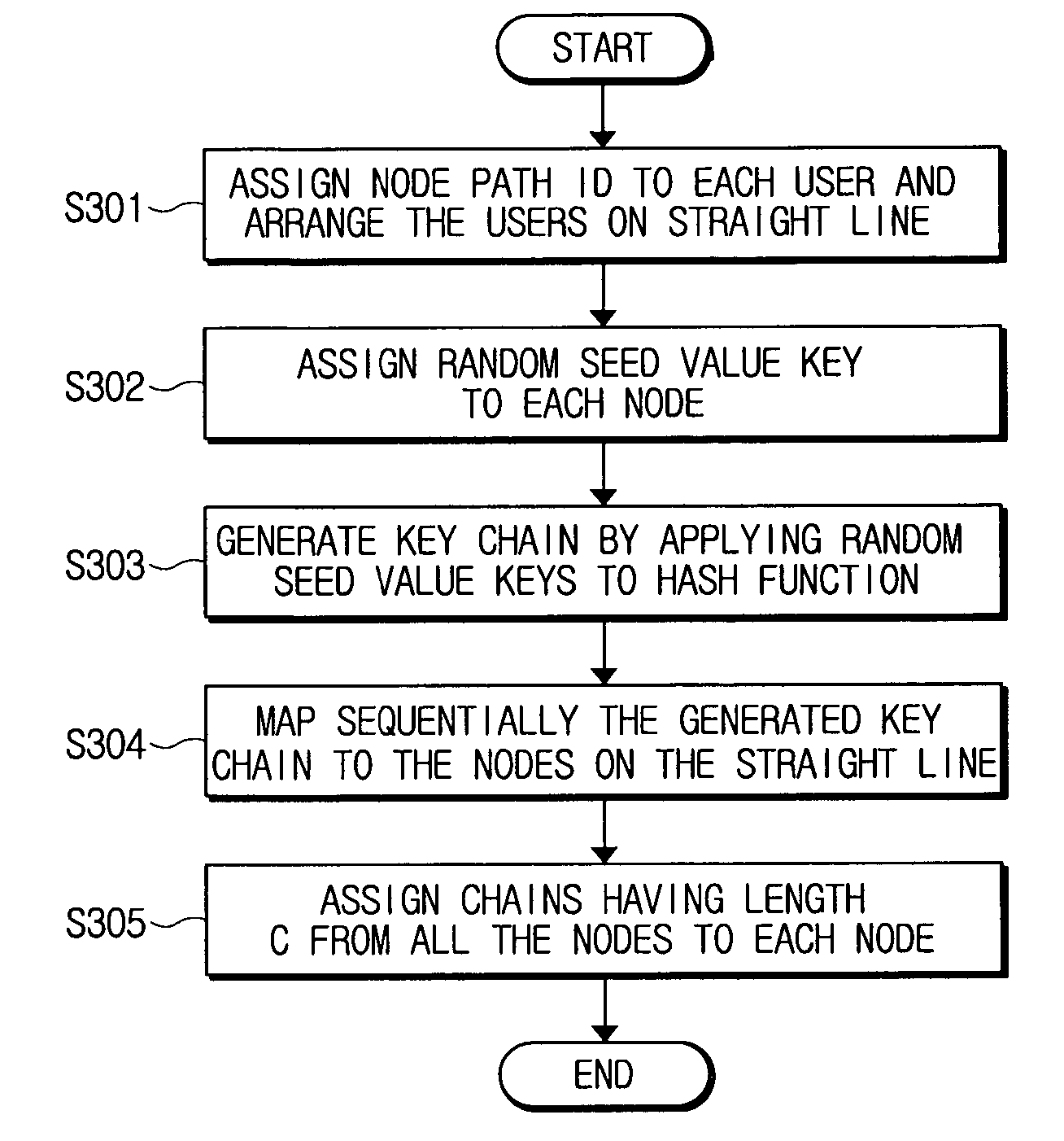Method of managing user key for broadcast encryption
a technology of user key and broadcast encryption, applied in the field of broadcast encryption, can solve the problems of reduced transmission overhead, inability to use practicably, and disadvantageous efficiency of sd method, and achieve the effect of reducing transmission overhead
- Summary
- Abstract
- Description
- Claims
- Application Information
AI Technical Summary
Benefits of technology
Problems solved by technology
Method used
Image
Examples
first modified exemplary embodiment
[0122] In the basic exemplary embodiment described above, the transmission overhead is greater than r because the length of an interval is limited to c. Accordingly, to reduce the transmission overhead to as much as r, the first modified exemplary embodiment, which transmit the keys by one transmission to a longer interval than c is proposed.
[0123] In the first modified exemplary embodiment of the present invention, special nodes are set in a certain interval, for example, for every 3-th node. Then, special seed value keys randomly selected and different from the existing seed value keys are assigned to the respective special nodes, and a special node chain starting from one special node key is constructed.
[0124]FIG. 12 is a view showing definition of the special nodes in the straight line structure in accordance with the first modified exemplary embodiment of the present invention. Referring to FIG. 12, the special nodes 1201, 1202 and 1203 are set for every c-th node. The specia...
second modified exemplary embodiment
[0136] According to the first modified exemplary embodiment, it is possible to obtain the transmission overhead which is approximately the same as r. That method shows the best result in the transmission overhead among the currently known methods such as the SD method with the transmission overhead of 2r−1. A second modified exemplary embodiment to be described hereinafter can reduce the transmission overhead to as much as less than r.
[0137] The basic concept of the second modified exemplary embodiment is as follows. In a case that a set of users positioned between two revoked users is regarded as an interval, the total number of intervals can never be below r in the worse case. In such cases, since one transmission should be made for each interval, it is impossible that the transmission overhead becomes less than r. Thus, it is necessary to alter a method of defining an interval.
[0138] Accordingly, a transmission interval can be set by including more than one revoked user in the ...
third modified exemplary embodiment
[0151] A third modified exemplary embodiment of the present invention is derived by combining the first and second modified exemplary embodiments. In this case, it is the worst case when every interval having a length c includes one revoked user. In a case that an interval having the length less than c includes two or more revoked users, the transmission for the two revoked users can be carried out at a time by using the second modified described above. The transmission overhead and storage overhead in such worst case are r / 2+(N−2r) / 2(c−2) and c+c2+(c−1)(c−2) / 2, respectively.
[0152] The transmission overhead r / 2+(N−2r) / 2(c−2) can be applied to the case that r is greater than N / c. If r is smaller than N / c, different results are obtained. For example, assuming that r equals zero, the transmission overhead becomes N / (c×c2). At this time, as r gradually increases, the transmission is needed once for the interval including the revoked users and having the length c. Further, since the met...
PUM
 Login to View More
Login to View More Abstract
Description
Claims
Application Information
 Login to View More
Login to View More - R&D
- Intellectual Property
- Life Sciences
- Materials
- Tech Scout
- Unparalleled Data Quality
- Higher Quality Content
- 60% Fewer Hallucinations
Browse by: Latest US Patents, China's latest patents, Technical Efficacy Thesaurus, Application Domain, Technology Topic, Popular Technical Reports.
© 2025 PatSnap. All rights reserved.Legal|Privacy policy|Modern Slavery Act Transparency Statement|Sitemap|About US| Contact US: help@patsnap.com



